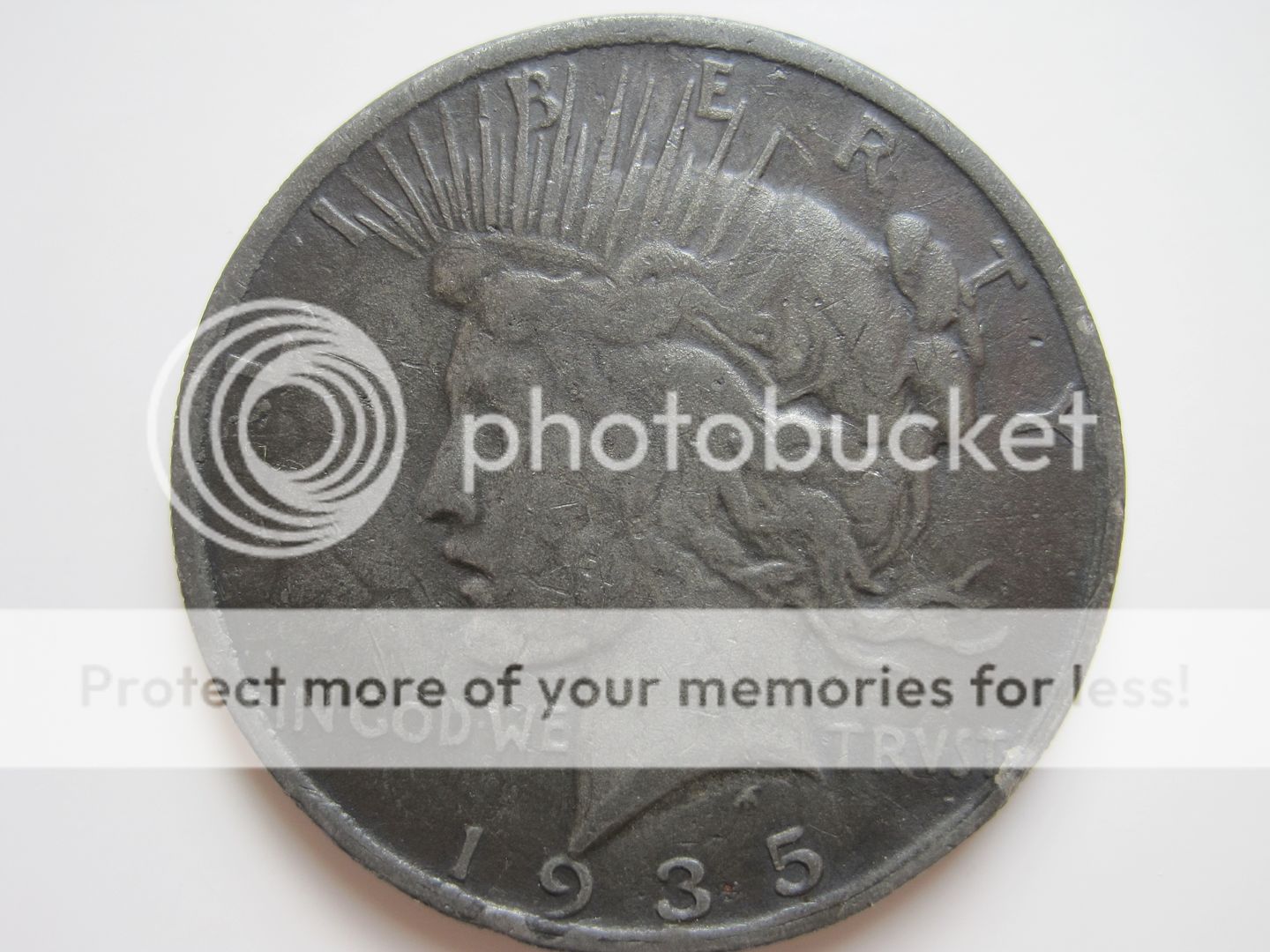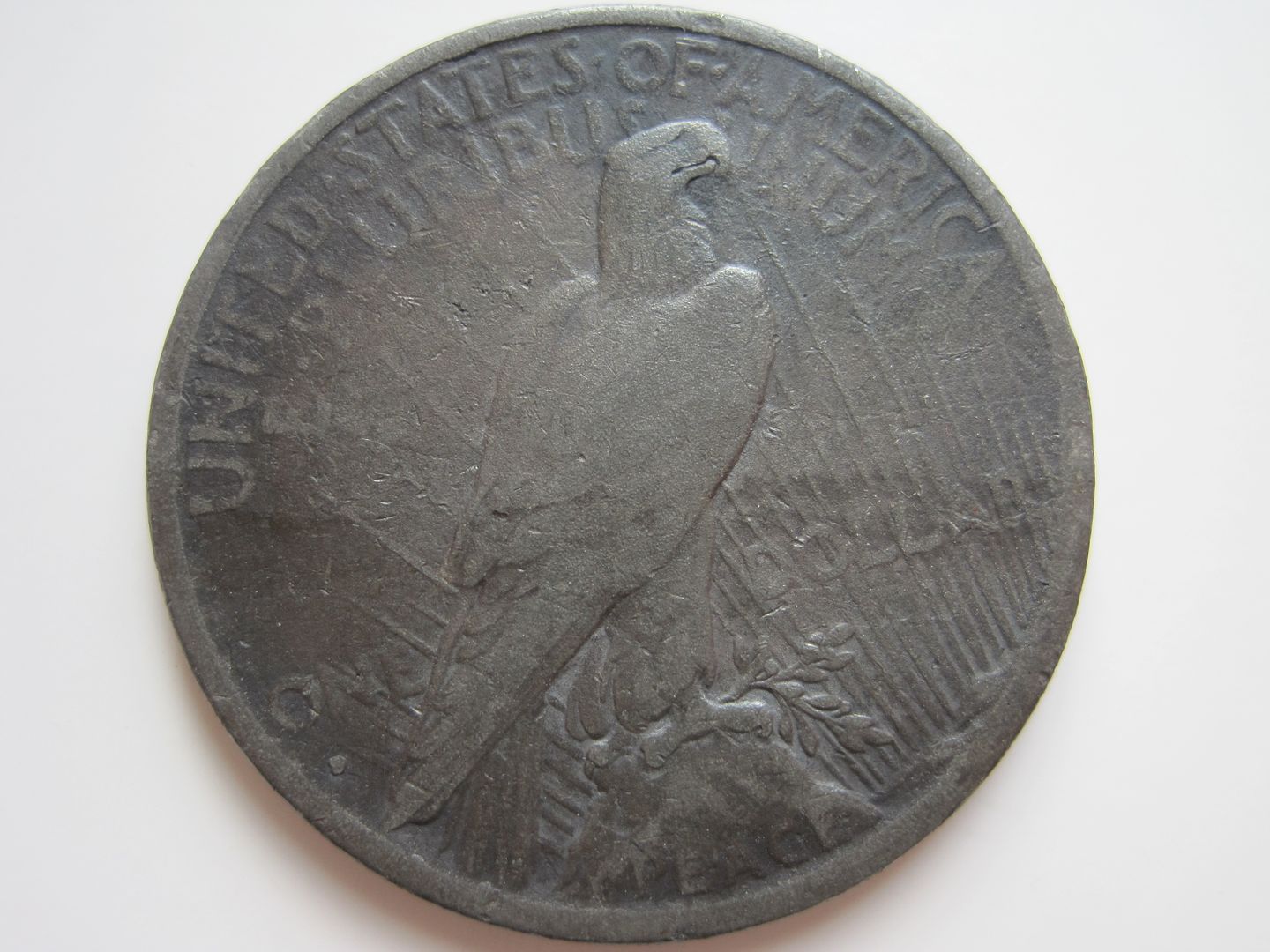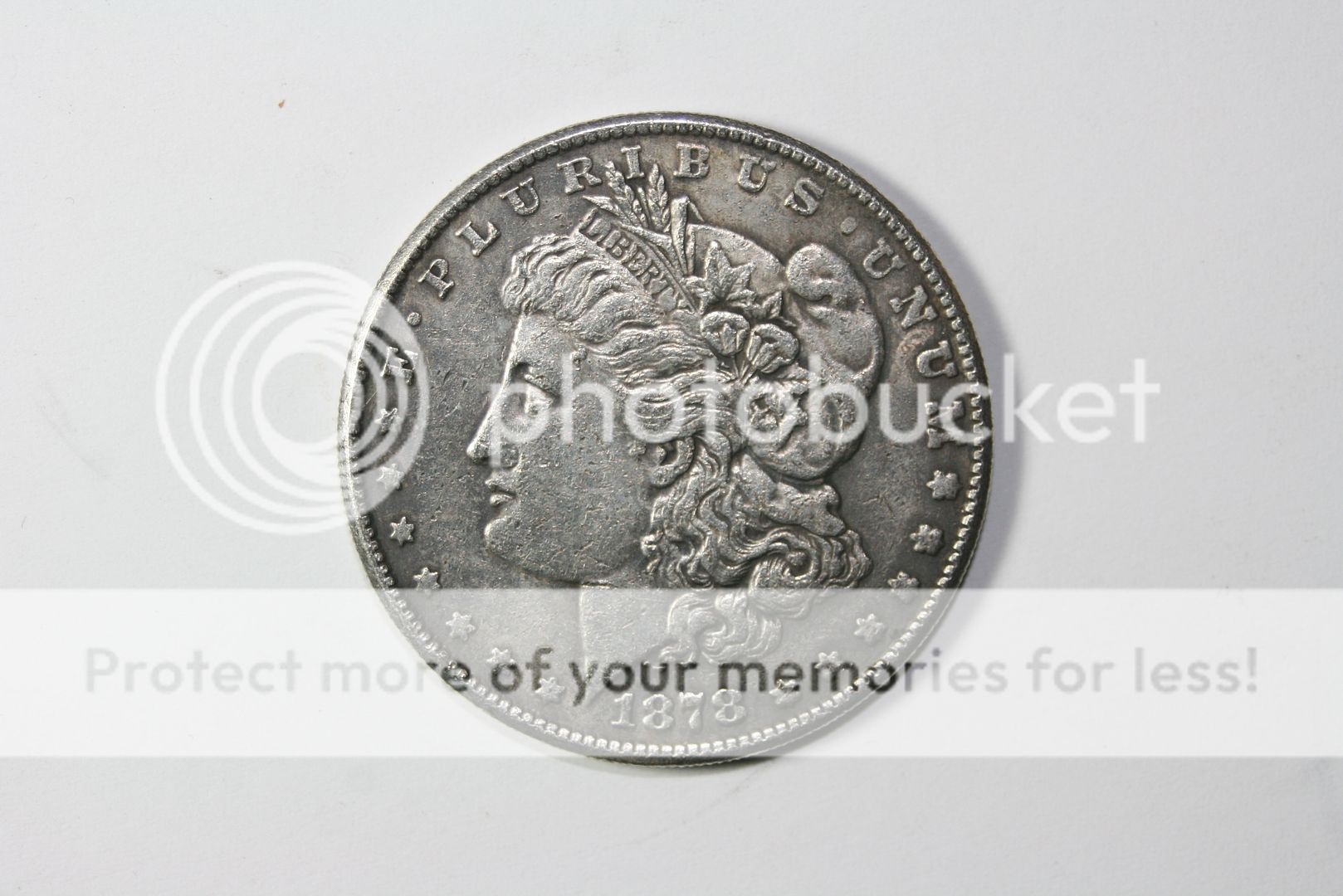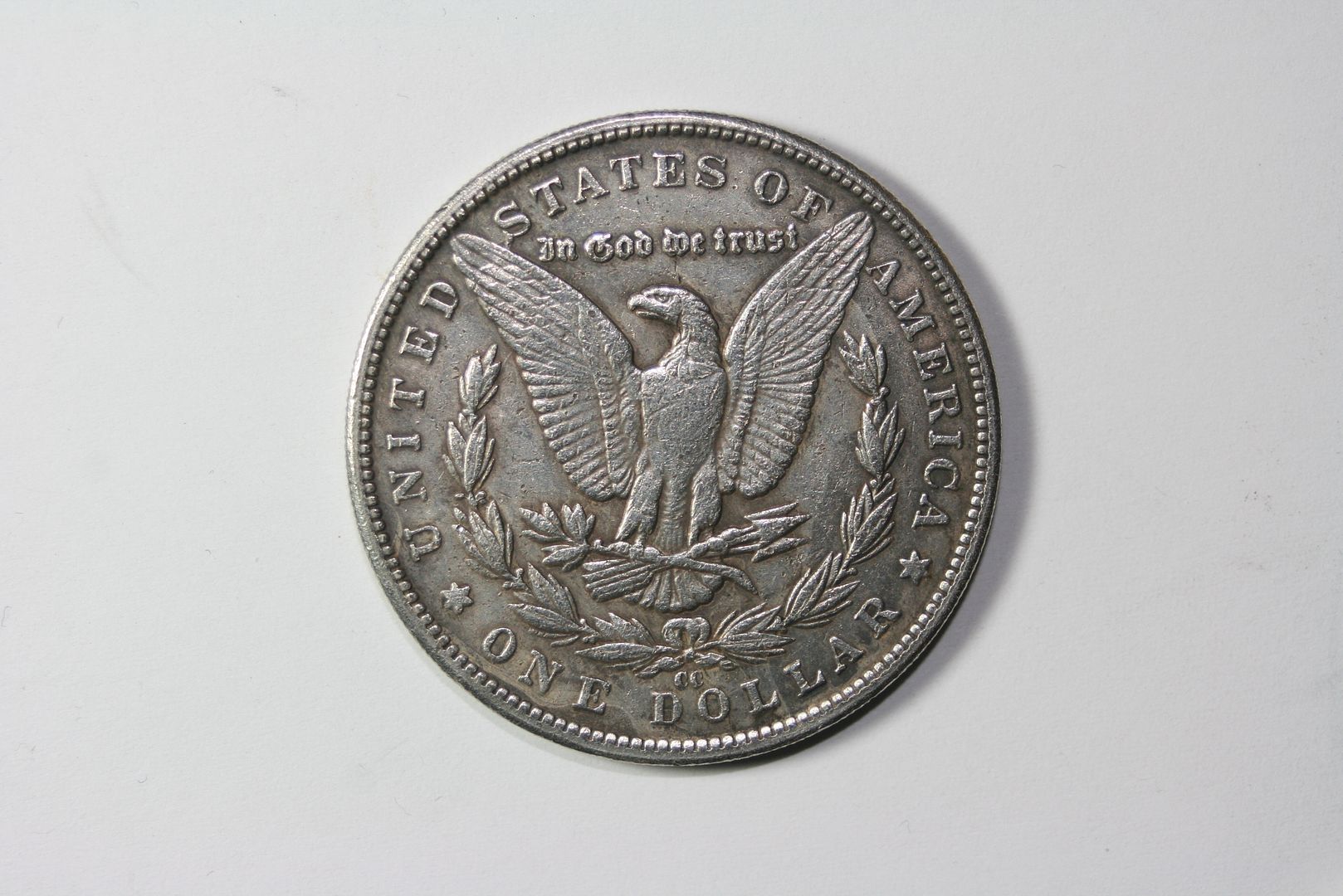I am unsure. I obtained it in 1982 by answering an ad in Coin World. It cost me $40 in 90% silver in trade. I sent this in to ANACS and it came back "non-genuine". I guess the seller's P.O. Box address should have been a big red flag.
What are pipe stones? I think I might have saw a few of them today at a jewelry/coin store. I remember seeing what looked like lil elephant tusks coming out of brass fittings, what looked like an old straight pipe. If so, let me know and I will go back and take pics for you.
When I first joined the forum I was primarily interested in currency. The "Pipestones" that are referenced in my by-line refer to the National Currency notes that were issued by Pipestone, MN, which is where I lived for much of my youth. The town took it's name in the late 1870's from the nearby red rock quarries that the local Native Americans carved items for their own culture and for trade....a practice that goes on to this day.
This coin was recently posted on a Dealer’s Face Book page as a contemporary counterfeit. After careful review it was determined to be an altered date 1858.
What makes it more interesting is it was actually cataloged in a 1994 Stacks auction, but then shown withdrawn. Apparently it was "discovered" prior to the actual sale.
I sent a note to both Harvey Stack and David Bowers and they said it wasn't unusual to return an item like this in the original flip to the consignor; both stated they were glad it hadn’t been sold!
@cardinal said:
This one was so good, it was purchased by an experienced coin dealer for $88,000 in 1980!
When these first came out they were state-of-the art. These deceived lots of folks. They are written up in Counterfeit Detection a Reprint from the Numismatist. Unfortunately, the ANACS authenticators wrote that these fakes were cast counterfeits. They are not.
IMO, any counterfeit that is slabbed as genuine by a major TPGS is a "great one." At the time they are finally detected, they are the State-of-the-Art fakes I referred to above.
@cardinal said:
This one was so good, it was purchased by an experienced coin dealer for $88,000 in 1980!
When these first came out they were state-of-the art. These deceived lots of folks. They are written up in Counterfeit Detection a Reprint from the Numismatist. Unfortunately, the ANACS authenticators wrote that these fakes were cast counterfeits. They are not.
Indeed! They are not cast counterfeits, they are die-struck, and they ring like a bell when tapped on the edge -- just like a real one!
@Insider2 said:
IMO, any counterfeit that is slabbed as genuine by a major TPGS is a "great one." At the time they are finally detected, they are the State-of-the-Art fakes I referred to above.
Agreed; as we both know the 1872-s was slabbed actually twice by two different TPGs.
This piece is one of those German silver contemporary counterfeits that Don Taxy covered in his "Counterfeit and Mistruck" book back in the 1960s. It has a lettered edge instead of a reeded one.
For those who are not familiar with the type, here is a genuine 1837 half dollar.
Retired dealer and avid collector of U.S. type coins, 19th century presidential campaign medalets and selected medals. In recent years I have been working on a set of British coins - at least one coin from each king or queen who issued pieces that are collectible. I am also collecting at least one coin for each Roman emperor from Julius Caesar to ... ?
How did they make it looks worn and circulated or was it indeed circulated over the years?
@BillJones said:
This piece is one of those German silver contemporary counterfeits that Don Taxy covered in his "Counterfeit and Mistruck" book back in the 1960s. It has a lettered edge instead of a reeded one.
For those who are not familiar with the type, here is a genuine 1837 half dollar.
@CoinscratchFever said:
Here is the only one I am aware of and only because they told me so! However, in an earlier thread @jmlanzaf said I have a couple in a pic of several silver dollars. I still haven't figured out which ones he was talking about. I'm beginning to think he was just a lil' hot under the collar... !
Me? Never
All comments reflect the opinion of the author, even when irrefutably accurate.
@Paradisefound said:
How did they make it looks worn and circulated or was it indeed circulated over the years?
@BillJones said:
This piece is one of those German silver contemporary counterfeits that Don Taxy covered in his "Counterfeit and Mistruck" book back in the 1960s. It has a lettered edge instead of a reeded one.
For those who are not familiar with the type, here is a genuine 1837 half dollar.
The counterfeiter makes of with less detail in their dies, probably runs it through a rock tumbler to put more “wear” on it. The low detail dies were seen in colonial times. If the coin looked worn, it met that other people had accepted it, which means that it must be good, right? That was the logic, which probably met it worked much of the time.
Retired dealer and avid collector of U.S. type coins, 19th century presidential campaign medalets and selected medals. In recent years I have been working on a set of British coins - at least one coin from each king or queen who issued pieces that are collectible. I am also collecting at least one coin for each Roman emperor from Julius Caesar to ... ?
The "c word" is taboo to many here. It looks like a fantasy coin to me. No known micro O genuine coins exist; thus, no one could possibly be fooled. No need to bother complying with the HPA or hiring competent counsel to do basic legal research first either: Since there are no micro "O" coins it couldn't be a copy according to forum legal experts per their "Ask Jeeves" web searches and Law and Order legal procedure lectures.
The "c word" is taboo to many here. It looks like a fantasy coin to me. No known micro O genuine coins exist; thus, no one could possibly be fooled. No need to bother complying with the HPA or hiring competent counsel to do basic legal research first either: Since there are no micro "O" coins it couldn't be a copy according to forum legal experts per their "Ask Jeeves" web searches and Law and Order legal procedure lectures.
The vintage privately-made ("micro-o") Morgan dollars were made with intent to deceive, via the spending of them at the apparent face value (while the total cost to the maker was less than 50 cents each). A million or more of them, using at least 34 different die pairs, were likely produced by the same maker. I've been collection them, but I have basically no chance of obtaining one example from each die pair. Regardless of whether it is considered a "fantasy" or a "counterfeit", the high-grade 1896-o micro-o pictured above would probably sell for $1,000 or more to a knowledgeable collector (no, I do not have it for sale presently).
@CoinscratchFever said:
Here is the only one I am aware of and only because they told me so! However, in an earlier thread @jmlanzaf said I have a couple in a pic of several silver dollars. I still haven't figured out which ones he was talking about. I'm beginning to think he was just a lil' hot under the collar... !
@CoinscratchFever said:
Here is the only one I am aware of and only because they told me so! However, in an earlier thread @jmlanzaf said I have a couple in a pic of several silver dollars. I still haven't figured out which ones he was talking about. I'm beginning to think he was just a lil' hot under the collar... !
Me? Never
Hi! How you doing today?
Good. You?
All comments reflect the opinion of the author, even when irrefutably accurate.
Very educational; thanks.
PS: I'm sorry but I have no counterfeits (whispering: that I know of) but I sure like that 1896 O.
For a fake it's rather pretty.
The "c word" is taboo to many here. It looks like a fantasy coin to me. No known micro O genuine coins exist; thus, no one could possibly be fooled. No need to bother complying with the HPA or hiring competent counsel to do basic legal research first either: Since there are no micro "O" coins it couldn't be a copy according to forum legal experts per their "Ask Jeeves" web searches and Law and Order legal procedure lectures.
Actually, those coins that don't exist are called "Small O" in VAM. Check it out.
@CoinscratchFever said:
Here is the only one I am aware of and only because they told me so! However, in an earlier thread @jmlanzaf said I have a couple in a pic of several silver dollars. I still haven't figured out which ones he was talking about. I'm beginning to think he was just a lil' hot under the collar... !
Me? Never
Hi! How you doing today?
Good. You?
Very good, found my very first doubled die this weekend. It wasn't the '58 1c but you know somethings better than nothing.
Just got two of the very rare Henning nickel dates but no pic yet. In the meantime, here is maybe the King of Contemporary counterfeits, the famous 1787 Half Dollar. There are three varieties of the 1787, all are extremely rare and less than 12 known of the entire series. Very lucky to own two of them, including this one.
New England Rarities...Dealer In Colonial Coinage and Americana
Nope. I'm looking, I'm lost. So it's a counterfeit in genuine slab?
It is a very high quality counterfeit that unfortunately evaded detection at our host - these are becoming quite a problem in the early American copper community.
Take a look at ONE CENT on the reverse.
"You can't get just one gun." "You can't get just one tattoo." "You can't get just one 1796 Draped Bust Large Cent."
Comments
When I first joined the forum I was primarily interested in currency. The "Pipestones" that are referenced in my by-line refer to the National Currency notes that were issued by Pipestone, MN, which is where I lived for much of my youth. The town took it's name in the late 1870's from the nearby red rock quarries that the local Native Americans carved items for their own culture and for trade....a practice that goes on to this day.

An obvious fake, picked up years ago.... Cheers, RickO

This coin was recently posted on a Dealer’s Face Book page as a contemporary counterfeit. After careful review it was determined to be an altered date 1858.
What makes it more interesting is it was actually cataloged in a 1994 Stacks auction, but then shown withdrawn. Apparently it was "discovered" prior to the actual sale.
I sent a note to both Harvey Stack and David Bowers and they said it wasn't unusual to return an item like this in the original flip to the consignor; both stated they were glad it hadn’t been sold!
When these first came out they were state-of-the art. These deceived lots of folks. They are written up in Counterfeit Detection a Reprint from the Numismatist. Unfortunately, the ANACS authenticators wrote that these fakes were cast counterfeits. They are not.
They are not.
One of my best appearing, but technically one of the worst!


Loosely a "fantasy" piece, the obverse is from a Philly 1872, the reverse a San Fran 1875-s and the reeding of an 1876 by reed count.
IMO, any counterfeit that is slabbed as genuine by a major TPGS is a "great one." At the time they are finally detected, they are the State-of-the-Art fakes I referred to above.
Indeed! They are not cast counterfeits, they are die-struck, and they ring like a bell when tapped on the edge -- just like a real one!
Showed it to a well known coin dealer who determined it was counterfeit
Great thread! All of my coins are real though.
My YouTube Channel
Agreed; as we both know the 1872-s was slabbed actually twice by two different TPGs.
This piece is one of those German silver contemporary counterfeits that Don Taxy covered in his "Counterfeit and Mistruck" book back in the 1960s. It has a lettered edge instead of a reeded one.
For those who are not familiar with the type, here is a genuine 1837 half dollar.
How did they make it looks worn and circulated or was it indeed circulated over the years?
Contemporary counterfeits were made at the time to deceive and circulate; very cool pieces and quite collectible!
I own one of these as well, in an ICG counterfeit holder; the counterfeiters missed the fact the design changed to "50 CENTS" on the reverse!
Me? Never
All comments reflect the opinion of the author, even when irrefutably accurate.
My latest addition and last one for the night...
The counterfeiter makes of with less detail in their dies, probably runs it through a rock tumbler to put more “wear” on it. The low detail dies were seen in colonial times. If the coin looked worn, it met that other people had accepted it, which means that it must be good, right? That was the logic, which probably met it worked much of the time.
"Best" can mean many things. So here are a few of mine (no, I did not manufacture any of these):
Best certified vintage counterfeit. 1893-O Morgan PCGS VG10. "Privately Made" VAM-7 (reverse hub of 1900 with wide gap between neck and wing):


Highest grade vintage counterfeit. 1896-o Morgan micro-o MS-64. "Privately Made" VAM-4:


Favorite "circ-cam" (off-metal) vintage counterfeit. 1853 3-cent:


Most deceptive counterfeit. China Sinkiang [1905] Sar (with correct silver content, weight, and diameter):


The "c word" is taboo to many here. It looks like a fantasy coin to me. No known micro O genuine coins exist; thus, no one could possibly be fooled. No need to bother complying with the HPA or hiring competent counsel to do basic legal research first either: Since there are no micro "O" coins it couldn't be a copy according to forum legal experts per their "Ask Jeeves" web searches and Law and Order legal procedure lectures.
The vintage privately-made ("micro-o") Morgan dollars were made with intent to deceive, via the spending of them at the apparent face value (while the total cost to the maker was less than 50 cents each). A million or more of them, using at least 34 different die pairs, were likely produced by the same maker. I've been collection them, but I have basically no chance of obtaining one example from each die pair. Regardless of whether it is considered a "fantasy" or a "counterfeit", the high-grade 1896-o micro-o pictured above would probably sell for $1,000 or more to a knowledgeable collector (no, I do not have it for sale presently).
Hi! How you doing today?
Good. You?
All comments reflect the opinion of the author, even when irrefutably accurate.
Very educational; thanks.
PS: I'm sorry but I have no counterfeits (whispering: that I know of) but I sure like that 1896 O.
For a fake it's rather pretty.
Actually, those coins that don't exist are called "Small O" in VAM. Check it out.
Very good, found my very first doubled die this weekend. It wasn't the '58 1c but you know somethings better than nothing.
I looked for a 1914-d. In circulation for my set. found 2 altered before finding the real thing.
I saw that. Congratulations! Sometimes things do pop up.
All comments reflect the opinion of the author, even when irrefutably accurate.
Interesting thread, thanks to all that contributed.
This one isn't very convincing bacause of the metal but the design is very close.


Click on this link to see my ebay listings.
Here's another that's not very convincing...


Click on this link to see my ebay listings.
Not very convincing, but very old...
What is now proved was once only imagined. - William Blake
@Regulated said:
Like the intricate work on the feathers
That was my favorite bit. Just added this to my collection on Saturday...
What is now proved was once only imagined. - William Blake
I like how it is parsed - UNI THD STATES OF AME RICA
Pacific Northwest Numismatic Association
It appears I have too many.

The "best"? Perhaps the gold dollar
Pacific Northwest Numismatic Association
1885cc-morgan-sold as a fake-

Who here has a counterfeit within their collection (that is so good) they are not aware of it?
Couple of new adds:


I know some in the numismatic community are not fond of counterfeits. I find the how, when, where and why interesting.
Disclaimer: I'm not a dealer, trader, grader, investor or professional numismatist. I'm just a hobbyist. (To protect me but mostly you! 🤣 )
Just got two of the very rare Henning nickel dates but no pic yet. In the meantime, here is maybe the King of Contemporary counterfeits, the famous 1787 Half Dollar. There are three varieties of the 1787, all are extremely rare and less than 12 known of the entire series. Very lucky to own two of them, including this one.
Disclaimer: I'm not a dealer, trader, grader, investor or professional numismatist. I'm just a hobbyist. (To protect me but mostly you! 🤣 )
Is that a counterfeit?
Disclaimer: I'm not a dealer, trader, grader, investor or professional numismatist. I'm just a hobbyist. (To protect me but mostly you! 🤣 )
Yup... do you know what it was struck on?
Take a close look...
"You can't get just one gun." "You can't get just one tattoo." "You can't get just one 1796 Draped Bust Large Cent."
Nope. I'm looking, I'm lost. So it's a counterfeit in genuine slab?
Disclaimer: I'm not a dealer, trader, grader, investor or professional numismatist. I'm just a hobbyist. (To protect me but mostly you! 🤣 )
It is a very high quality counterfeit that unfortunately evaded detection at our host - these are becoming quite a problem in the early American copper community.
Take a look at ONE CENT on the reverse.
"You can't get just one gun." "You can't get just one tattoo." "You can't get just one 1796 Draped Bust Large Cent."
Yes, so I'm seeing some type of counter stamp here.
Disclaimer: I'm not a dealer, trader, grader, investor or professional numismatist. I'm just a hobbyist. (To protect me but mostly you! 🤣 )
Note the star in front of her lips.